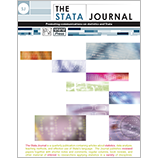Semiparametric analysis of case–control genetic data in the presence of environmental factors
Yulia V. Marchenko
StataCorp
College Station, TX
[email protected]
|
Raymond J. Carroll
Department of Statistics
Texas A&M University
College Station, TX
[email protected]
|
Danyu Y. Lin
Department of Biostatistics
University of North Carolina
Chapel Hill, NC
[email protected]
|
Christopher I. Amos
M. D. Anderson Cancer Research Center
Houston, TX
[email protected]
|
Roberto G. Gutierrez
StataCorp
College Station, TX
[email protected]
|
Abstract.
In the past decade, many statistical methods have been proposed for the
analysis of case–control genetic data with an emphasis on
haplotype-based disease association studies. Most of the methodology has
concentrated on the estimation of genetic (haplotype) main effects. Most
methods accounted for environmental and gene–environment interaction
effects by using prospective-type analyses that may lead to biased estimates
when used with case–control data. Several recent publications
addressed the issue of retrospective sampling in the analysis of
case–control genetic data in the presence of environmental factors by
developing efficient semiparametric statistical methods. This article
describes the new Stata command haplologit, which implements
efficient profile-likelihood semiparametric methods for fitting
gene–environment models in the very important special cases of a rare
disease, a single candidate gene in Hardy–Weinberg equilibrium, and
independence of genetic and environmental factors.
View all articles by these authors:
Yulia V. Marchenko, Raymond J. Carroll, Danyu Y. Lin, Christopher I. Amos, Roberto G. Gutierrez
View all articles with these keywords:
haplologit, haplotype-based analysis, haplotype–environment independence, case–control data, Hardy–Weinberg equilibrium, profile likelihood, retrospective study, single nucleotide polymorphisms (SNPs)
Download citation: BibTeX RIS
Download citation and abstract: BibTeX RIS
|
